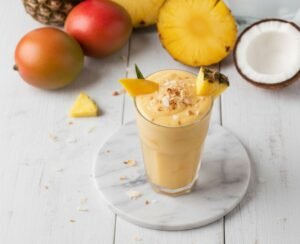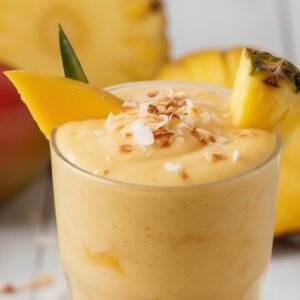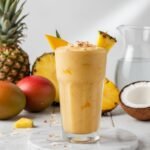Imagine you’re sitting on a sunny beach, the sound of gentle waves crashing nearby, a cool breeze brushing your skin, and in your hand—a chilled glass of tropical bliss. That’s exactly what a Tropical Mango Coconut Smoothie feels like. This smoothie doesn’t just quench your thirst—it’s a flavor vacation for your senses. With the sweetness of ripe mangoes, the tangy zest of pineapple, and the refreshing smoothness of coconut water, every sip is pure sunshine in a glass.
What makes it even better is that it’s not just delicious—it’s also incredibly nutritious. Packed with vitamins, minerals, natural electrolytes, and a good dose of protein, this smoothie keeps your body hydrated, fueled, and satisfied. Whether you’re starting your morning, cooling off after a workout, or craving something refreshing in the afternoon, this smoothie is your go-to tropical escape.
Let’s dive deep into the ingredients, their benefits, and how you can blend your way to paradise right in your kitchen.
The Magic Behind Tropical Flavors
There’s something irresistible about tropical fruits. The moment you slice into a mango or pineapple, that sweet aroma instantly transports you somewhere warm and vibrant. Tropical fruits are naturally juicy, sweet, and bursting with life—making them the perfect stars for a smoothie.
Mangoes bring a creamy texture and natural sweetness, while pineapples add a tangy punch that balances the flavors beautifully. And then there’s coconut water—light, refreshing, and packed with electrolytes that make every sip hydrating and smooth. When combined, these three ingredients create a harmony of flavors that’s both exotic and comforting.
Beyond taste, tropical fruits are nutrient-dense powerhouses. They’re rich in vitamin C, potassium, fiber, and antioxidants, which help fight free radicals and support overall health. So, every time you drink this smoothie, you’re not just enjoying a treat—you’re nourishing your body in the most delicious way possible.
Nutritional Benefits of Mangoes
If there’s one fruit that symbolizes the tropics, it’s the mango. Often called the “king of fruits,” mangoes are loaded with vitamins A and C, along with beta-carotene, potassium, and magnesium. These nutrients are essential for boosting immunity, promoting glowing skin, and supporting heart health.
Mangoes also contain digestive enzymes like amylases, which help break down carbohydrates into simpler sugars. That means your body digests mangoes easily and efficiently. And if you’re concerned about calories—relax! A cup of mango chunks has about 100 calories, but those calories come packed with fiber and nutrients that keep you full and satisfied.
Their vibrant orange color hints at their high antioxidant content, particularly carotenoids that promote eye health and reduce inflammation. Whether you’re blending them into a smoothie or eating them fresh, mangoes bring a burst of sunshine to your diet in both taste and nutrition.
The Power of Pineapple
Pineapple is like nature’s candy—it’s sweet, juicy, and slightly tangy, making it the perfect complement to mango. But beyond taste, pineapple is also a nutrient powerhouse. It’s rich in vitamin C, which supports immune function and collagen production, helping keep your skin firm and youthful.
The real magic in pineapple lies in bromelain, an enzyme that helps with digestion and reduces inflammation. This makes your smoothie not just refreshing but also gentle on your stomach. Bromelain has been shown to support post-workout recovery, making pineapple an ideal ingredient for an energizing and restorative smoothie.
It’s also naturally hydrating and adds a burst of tropical brightness that enhances any smoothie blend. Together with mango and coconut, pineapple turns a simple drink into a vibrant tropical treat that’s as nourishing as it is delicious.
Why Coconut Water Is the Perfect Base
Coconut water is nature’s version of a sports drink—but without all the artificial additives. When you pour it into your smoothie, you’re not just adding liquid; you’re adding hydration, electrolytes, and a touch of tropical sweetness. It’s loaded with potassium, magnesium, and calcium—minerals your body needs to stay hydrated and energized, especially after a workout or a long day in the sun.
Unlike regular milk or juice, coconut water has a subtle, refreshing taste that doesn’t overpower the other ingredients. It lets the mango and pineapple shine while tying everything together with its silky texture. Plus, it’s naturally low in calories and sugar, making your smoothie both light and nutritious.
If you’re someone who often skips water during the day, blending coconut water into your smoothie is a sneaky and delicious way to stay hydrated. You can also use it as an alternative to dairy if you’re lactose-intolerant or vegan. It’s one of those rare ingredients that’s as good for your body as it tastes—and that’s saying a lot.
Protein in Your Smoothie: Why It Matters
A smoothie without protein is like a car without fuel—it might taste great, but it won’t keep you going for long. Protein helps repair muscles, supports tissue growth, and keeps you feeling full. When you add protein to your Tropical Mango Coconut Smoothie, you’re turning a refreshing drink into a satisfying, meal-worthy blend.
You can use protein powder (vanilla or unflavored works best), Greek yogurt, or even silken tofu for a vegan alternative. Greek yogurt adds creaminess while delivering about 10 grams of protein per serving. If you’re looking to build muscle or just need an energy boost for your day, this addition makes a huge difference.
The beauty of this smoothie is that you can easily adjust its protein content to match your goals. Want a post-workout recovery drink? Add a scoop of whey protein. Prefer something lighter? Stick to coconut water and fruit. Either way, you’ll enjoy a nutrient-packed tropical delight that satisfies your taste buds and your body.
Choosing the Right Mango for Your Smoothie
Not all mangoes are created equal—and choosing the right one can take your smoothie from good to unforgettable. There are dozens of mango varieties around the world, but the most popular ones include Ataulfo (Honey Mango), Haden, and Tommy Atkins.
Ataulfo mangoes are small, golden, and buttery smooth, perfect for a creamy texture. Haden mangoes are slightly tangy with vibrant orange flesh, while Tommy Atkins are firmer and hold up well if you’re using frozen chunks. For the sweetest flavor, always go for mangoes that yield slightly when pressed and have a fragrant, fruity aroma.
If fresh mangoes aren’t available, don’t worry—frozen mango chunks work beautifully. They’re picked at peak ripeness and retain most of their nutrients. Plus, they help make your smoothie thicker and colder without needing ice. Remember, ripe mangoes add natural sweetness, so you won’t need extra sugar or honey.
Fresh vs. Frozen Fruits: What Works Best?
This is one of the biggest smoothie debates out there: fresh or frozen? The truth is, both have their perks. Fresh fruits deliver bright flavors and vibrant colors, perfect if your ingredients are in season. However, frozen fruits are incredibly convenient and often just as nutritious, since they’re frozen right after harvest to lock in vitamins and minerals.
Using frozen mango or pineapple gives your smoothie a thicker, creamier texture—almost like a milkshake. It also keeps the smoothie cold longer without watering it down with ice. On the other hand, if you’ve got fresh, ripe fruit sitting on your counter, go ahead and use it! Just add a few ice cubes or freeze the fruit for an hour before blending to get that frosty chill.
The best approach? Mix and match. Combine fresh coconut water with frozen mango and pineapple. This combo gives you the best of both worlds—fresh flavor and creamy texture.

Step-by-Step Recipe for the Perfect Tropical Mango Coconut Smoothie
Now let’s get to the best part—making it! Here’s how you can blend your way to paradise.
Ingredients:
-
1 cup ripe mango chunks (fresh or frozen)
-
½ cup pineapple chunks
-
1 cup coconut water
-
½ cup Greek yogurt or 1 scoop vanilla protein powder
-
1 tablespoon shredded coconut (optional for texture)
-
1 teaspoon honey or agave syrup (optional, for sweetness)
-
Ice cubes (if using fresh fruit)
Instructions:
-
Add the coconut water to your blender first. This helps the blades move easily.
-
Next, add the mango, pineapple, and Greek yogurt (or protein powder).
-
Toss in the shredded coconut for a little texture and tropical flair.
-
Add honey if you prefer a sweeter taste.
-
Blend on high speed for 45–60 seconds until smooth and creamy.
-
Taste and adjust sweetness or thickness. Add ice cubes if needed and blend again.
-
Pour into a chilled glass and enjoy immediately.
This recipe makes about two servings. Garnish with a slice of pineapple or a sprinkle of toasted coconut for that picture-perfect tropical vibe.
Customizing Your Smoothie
One of the best things about the Tropical Mango Coconut Smoothie is how flexible it is. You can easily tweak it to suit your taste, dietary preferences, or nutritional goals. Think of the base recipe as your canvas, and then get creative with the add-ins.
If you’re going dairy-free or vegan, simply skip the Greek yogurt and use a scoop of plant-based protein powder or silken tofu instead. You can also swap in almond milk, oat milk, or coconut milk for a creamier texture while keeping it 100% plant-based.
Want an extra burst of freshness? Add a squeeze of lime juice—it brightens up the tropical flavors beautifully. Fresh mint leaves can add a cooling twist, while a pinch of turmeric or ginger gives your smoothie an antioxidant and anti-inflammatory boost.
For added nutrition, blend in a handful of spinach or kale—their mild flavor gets masked by the sweetness of mango and pineapple, but you’ll get a big dose of vitamins and fiber. If you like some crunch, sprinkle chia seeds, flaxseeds, or shredded coconut on top.
You can also adjust the thickness of your smoothie depending on your mood. For a thicker, spoonable smoothie bowl, reduce the liquid and top it with granola, fruit slices, and coconut flakes. For a lighter, drinkable version, add extra coconut water. There’s no wrong way to enjoy this tropical masterpiece—it’s all about what makes your taste buds happiest.
How to Make It Meal-Worthy
If you’re looking to turn your smoothie into a complete meal, you’ll need to focus on balance—adding more protein, healthy fats, and fiber. This will help sustain your energy levels and keep you full for hours.
Start by adding a tablespoon of nut butter (like almond or cashew). It adds creaminess, richness, and a healthy dose of good fats. You can also toss in half an avocado—it blends perfectly and gives your smoothie that luxurious, velvety texture.
For extra fiber, include a couple of tablespoons of rolled oats or chia seeds. They not only thicken the smoothie but also make it more satisfying. Combine that with a scoop of protein powder or a serving of Greek yogurt, and you’ve got yourself a tropical breakfast that can easily replace your morning meal.
If you’re into smoothie bowls, pour your thick blend into a bowl and top it with fresh fruit slices, granola, shredded coconut, or hemp seeds. It’s colorful, nourishing, and gives you that spoon-worthy satisfaction.
Remember, the goal isn’t just to make something delicious—it’s to make something that fuels your body and fits your lifestyle. With the right mix of ingredients, your smoothie can be your breakfast, pre-workout drink, or even a light dinner on busy days.

Health Benefits of Tropical Smoothies
It’s no exaggeration to say that tropical smoothies are nutrient-packed elixirs. Every ingredient in this Mango Coconut Smoothie works together to support your health from head to toe.
Let’s break down the benefits:
-
Hydration: Coconut water provides natural electrolytes like potassium and magnesium, which keep you hydrated and help prevent muscle cramps.
-
Immunity Boost: Mango and pineapple are loaded with vitamin C and antioxidants that strengthen your immune system and help your body fight off infections.
-
Digestive Support: Pineapple’s bromelain enzyme aids digestion, while the fiber from mango helps keep your gut healthy.
-
Energy and Vitality: The natural sugars in tropical fruits provide quick energy without the crash, making this smoothie perfect for mornings or workouts.
-
Skin Health: The vitamin A and beta-carotene from mangoes promote glowing skin and improve collagen production.
-
Muscle Recovery: If you add protein powder or Greek yogurt, you’re also supporting muscle repair and recovery.
This smoothie isn’t just a drink—it’s a wellness ritual. With every sip, you’re hydrating your body, feeding your cells, and fueling your day the tropical way.
Common Mistakes to Avoid When Making Smoothies
Even the simplest smoothie can go wrong if you’re not careful. Here are a few common mistakes and how to fix them:
-
Using too much liquid:
It’s tempting to pour in a lot of coconut water, but too much can make your smoothie watery. Start with less and add more as needed until you reach your preferred consistency. -
Not blending long enough:
A few chunks of unblended fruit can ruin the texture. Blend for at least 45–60 seconds on high speed to get that perfectly smooth finish. -
Skipping protein or fiber:
If you’re using this smoothie as a meal, don’t forget to add protein powder, Greek yogurt, or oats. Without these, you’ll be hungry again in an hour. -
Over-sweetening:
The fruits are naturally sweet—so avoid adding too much honey, agave, or juice. If you want extra sweetness, opt for ripe mangoes instead. -
Using low-quality ingredients:
Always choose ripe, fresh, or high-quality frozen fruits. It makes a world of difference in both taste and nutrition.
Mastering the art of smoothie-making is all about balance—between flavor, nutrition, and texture. Avoid these pitfalls, and you’ll have a tropical drink that’s both refreshing and nourishing every time.
Storage Tips: Keeping Your Smoothie Fresh
Sometimes, you want to prep ahead or save some smoothie for later. The good news? You absolutely can. But to keep your Tropical Mango Coconut Smoothie fresh, follow a few smart storage tricks.
If you’re refrigerating, pour the smoothie into an airtight glass jar or a mason jar with a tight lid. It’ll stay fresh for up to 24–36 hours. Before drinking, give it a good shake or a quick stir since separation is natural.
For longer storage, freezing is your best bet. Pour your smoothie into freezer-safe containers or ice cube trays. Once frozen, transfer the cubes to a ziplock bag. When you’re ready for a smoothie, just toss a few cubes into the blender with a splash of coconut water, and voilà—instant tropical refreshment!
Avoid leaving smoothies at room temperature for long periods, as the fruit enzymes can ferment and change the taste. Proper storage keeps the flavors vibrant and the nutrients intact, ensuring every sip is as delicious as when it was first made.
Conclusion: Bringing Paradise to Your Blender
The Tropical Mango Coconut Smoothie is more than just a drink—it’s a vibrant, sunny experience captured in a glass. From the first sip, it takes you to palm-fringed beaches and crystal-clear waters, where life feels lighter and every moment tastes like summer. But what makes it truly special isn’t just its refreshing flavor—it’s how effortlessly it brings nutrition, hydration, and happiness together.
Each ingredient plays a vital role. Mango delivers creamy sweetness and a boost of vitamins. Pineapple brings that tangy spark and digestive support. Coconut water hydrates and refreshes, while your choice of protein makes it wholesome and satisfying. It’s the perfect balance of flavor and function—a tropical escape that also happens to be good for you.
And the best part? You don’t need a fancy café or exotic ingredients to enjoy it. With a blender and a few simple fruits, you can create your own mini vacation at home. Whether it’s breakfast on a busy morning, a post-workout pick-me-up, or an afternoon indulgence, this smoothie fits effortlessly into your day.
So go ahead—blend up a taste of the tropics, sip slowly, and let every swallow remind you that wellness can be delicious, and paradise is only a blender away.
FAQs
1. Can I make this smoothie without coconut water?
Absolutely! If you don’t have coconut water, you can substitute it with almond milk, oat milk, or even plain water. Just remember that coconut water adds natural electrolytes and a subtle sweetness, so if you skip it, you might want to add a bit of honey or extra fruit for flavor.
2. What can I use instead of pineapple?
If you’re not a fan of pineapple or simply don’t have it on hand, try using orange segments, peaches, or papaya. These fruits add similar tropical sweetness and pair beautifully with mango. You can even use a mix of frozen fruits for a fun twist.
3. Is this smoothie good for weight loss?
Yes! This smoothie is naturally low in fat, high in fiber, and full of hydrating ingredients. By skipping added sugars and sticking to whole fruits, it makes a great meal replacement or snack for weight management. Just make sure to keep portions moderate and include protein for satiety.
4. Can I prep it ahead of time?
Definitely. You can prepare the ingredients the night before and store them in an airtight container in the fridge. In the morning, just toss everything into the blender with coconut water. Alternatively, freeze pre-portioned fruit bags so you can have a smoothie ready in minutes.
5. How do I make it creamier?
For a thicker, creamier smoothie, reduce the liquid slightly and add one or more of the following: half a banana, avocado, Greek yogurt, or coconut milk. These ingredients give your smoothie a velvety texture and make it feel even more indulgent.
Tropical Mango Coconut Smoothie Recipe
- Prep Time: 5 minutes
- Total Time: 5 minutes
- Yield: 2
- Category: Smoothie
- Cuisine: American
Ingredients
- 1 cup ripe mango chunks (fresh or frozen)
- ½ cup pineapple chunks
- 1 cup coconut water
- ½ cup Greek yogurt or 1 scoop vanilla protein powder (for a vegan option, use plant-based protein)
- 1 tablespoon shredded coconut (optional, for texture)
- 1 teaspoon honey or agave syrup (optional, for sweetness)
- A handful of ice cubes (if using fresh fruit)
Instructions
- Add Liquid First: Pour the coconut water into your blender.
- Add Fruits & Protein: Toss in mango, pineapple, and Greek yogurt (or protein powder).
- Boost Texture: Add shredded coconut and honey if desired.
- Blend Until Smooth: Blend on high speed for 45–60 seconds until creamy and thick.
- Adjust Consistency: Add a bit more coconut water for a lighter drink or extra ice for a thicker texture.
- Serve & Enjoy: Pour into a chilled glass, garnish with pineapple slices or toasted coconut flakes, and sip your way to paradise!









